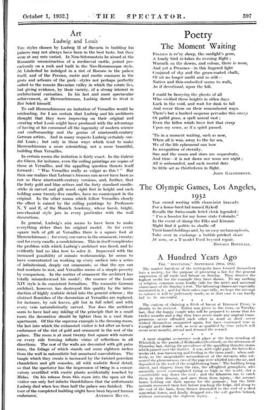Art
Ludwig and Louis THE styles chosen by Ludwig II of Bavaria in building his palaces may not always have been in the best taste, but they were at any rate varied. In Neu-Schwanstein he aimed at the Romantic reconstruction of a mediaeval castle, poised pre- cariously on a rock and built in the Neo-Romanesque style. At Linderhof he indulged in a riot of Rococo in the palace itself, and of the Persian, rustic and exotic manners in the grots and arbours of the park—styles not perhaps perfectly suited to the remote Bavarian valley in which the estate la s, but giving evidence, by their variety, of a strong interest in architectural curiosities. In his last and most spectacular achievement, at Herrenchiemsee, Ludwig dared to rival le Roi Soleil himself.
To call Herrenchiemsee an imitation of Versailles would be misleading, for I am certain that Ludwig and his architects thought that they were improving on their original and creating what Louis might have produced with the advantage of having at his command all the ingenuity of modem science and craftsmanship and the genius of nineteenth-century German artists. And in many respects Ludwig certainly out- did Louis ; but only in those ways which tend to make Herrenchiemsee a more astonishing, not a more beautiful, building than Versailles.
In certain rooms the imitation is fairly exact. In the Galerie des Glaccs, for instance, even the ceiling paintings are copies of those at Versailles, and the appalling question thrusts itself forward : " Was Versailles really as vulgar as this ? " But then one realizes that Lebrun's frescoes can never have been as raw as these nineteenth-century versions, and, further, that the forty gold and blue settees and the forty standard candle- sticks in carved and gilt wood, eight feet in height and each holding some twenty-five candles, have no counterpart in the original. In the other rooms which follow Versailles closely the effect is ruined by the ceiling paintings by Professors X, I' and Z, of the Munich Academy, whose harsh, bright, neo-classical style_ jars in every particular with the wall decorations.
In general, Ludwig's aim seems to have been to make everything richer than his original model. So for every square inch of gilt at Versailles there is a square foot at Herrenchiemsee ; for every one curve in the ornament, twenty; and for every candle, a candelabrum. This in itself complicates the problem with which Ludwig's architect was faced, and he evidently had no idea how to solve it. Impressed with the increased possibility of minute workmanship, he seems to have concentrated on working up every surface into a series of infinitesimal, deeply cut ornaments, so that the eye can find nowhere to rest, and Versailles seems of a simple poverty by comparison. In the matter of ornament the architect has totally misunderstood his model ; the essence of the Louis XIV style is its consistent formalism. The romantic German architect, however, has destroyed this quality by the intro- duction of highly realistic detail into the general scheme ; the abstract flourishes of the decoration at Versailles are replaced, for instance, by oak leaves, gilt but in full relief, and with every vein naturalistically carved. Nor does the architect seem- to have had any inkling of the principle that in a small room the decoration should be lighter than in a vast State apartment. Of this the supreme example is the dressing-room, the last into which the exhausted visitor is led after an hour's endurance of the riot of gold and ornament in the rest of the palace. The room is at most twenty foot square with mirrors on every side forming infinite vistas of reflections in all directions. The rest of the walls are decorated with gilt palm trees, the foliage of which stands out some eighteen inches from the wall in naturalistic but unnatural convolutions. The tangle which they create is increased by the twisted porcelain chandeliers and gilt consoles, all with realistic floral detail, so that the spectator has the impression of being in a conser- vatory overfilled with exotic plants accidentally touched by Midas. On his release from this room into the open air the visitor can only feel infinite thankfulness that the unfortunate Ludwig died when less than half the palace was finished. The tour of the completed building might have been beyond human














































 Previous page
Previous page